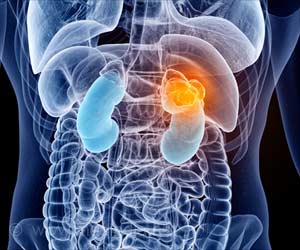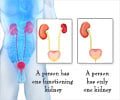Stereotactic ablative radiotherapy (SABR) is as safe and effective for patients who have only one kidney.

‘A specialized form of radiation treatment known as stereotactic ablative radiotherapy (SABR), also known as stereotactic body radiation therapy (SBRT), is emerging as a potential alternative for kidney cancer patients. ’





SABR has been shown to be effective in treating cancers in the lung, liver and spine using substantially higher doses of radiation delivered in a single, or just a few, treatment sessions. Earlier this year, a study published in the journal Cancer showed that SABR was safe and effective in treating patients with RCC who had both kidneys remaining. This new study shows it is just as safe and effective for patients who have only one kidney. "Although RCC historically has been considered resistant to conventional radiation therapy, the high doses and high precision achievable with SABR overcome this resistance," said lead author Rohann J. M. Correa, MD, PhD, a radiation oncology resident at London Health Sciences Center in London, Canada. "Kidney SABR is thus emerging as a versatile, non-invasive outpatient treatment requiring one visit or a few visits. Our analysis demonstrates SABR to be highly effective with minimal side effects for RCC patients with a single kidney."
Dr. Correa and his colleagues analyzed patient data from nine institutions across the United States, Germany, Australia, Canada and Japan within the International Radiosurgery Oncology Consortium for Kidney (IROCK) group. Of the 223 patients who underwent renal SABR, 81 had a solitary kidney. In the single-kidney cohort, patients were an average of 67.5 years old at time of treatment, mostly male (69 percent) and of good performance status (ECOG 0-1 in 97.5 percent). The median biologically-effective dose of radiation therapy was 87.5 Gray (Gy) and was identical in the solitary and bilateral cohorts (p=0.103).
With a median follow-up of 2.6 years, SABR provided 98 percent two-year local control and 98 percent two-year cancer-specific survival for RCC patients with a solitary kidney. These rates were not significantly different from those for patients with two kidneys treated with SABR: 97.8 percent local control (hazard ratio (HR) 0.89, p=0.923) and 94.3 percent cancer-specific survival (HR 0.16, p=0.082). Overall survival also did not differ between the cohorts, at 81 percent for the solitary group and 82 percent for the bilateral group (HR 0.75, p=0.445).
Renal function was modestly impacted by SABR. The decline in estimated glomerular filtration rate (eGFR) was similar for both cohorts, with average decreases of -5.8 (±10.8 mL/min) in the solitary cohort and -5.3 (±14.3 mL/min) in the bilateral cohort (p=0.984). None of the solitary kidney patients required dialysis, while six (4.2 percent) in the bilateral cohort did.
Advertisement
The research team used Cox hazards regression analysis to look at factors predicting which patients had worse outcomes after SABR. Larger tumor size (>4.0 cm) correlated with more profound decreases in eGFR after SABR (hazard ratio (HR) 4.2, p=0.029). "From this, we concluded that proper patient selection will be important in optimizing outcomes for solitary kidney patients treated with SABR," said Dr. Correa.
Advertisement
Source-Eurekalert















